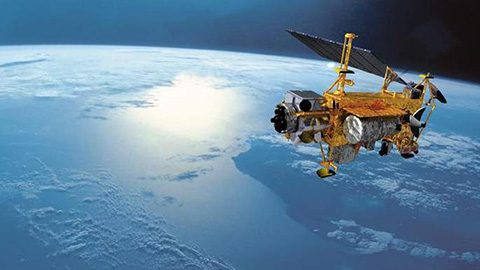Upper Atmosphere Research Satellite

Upper Atmosphere Research Satellite (9/1991 - 12/2005)
NASA's UARS satellite, launched in 1991 from the Space Shuttle, was the first multi-instrumented satellite to observe numerous chemical constituents of the atmosphere with a goal for better understanding atmospheric photochemistry and transport. It carried four instruments to measure the energy inputs from solar radiation and charged particles: SOLSTICE, SUSIM, PEM and ACRIM-2.
Solar Ultraviolet Spectral Irradiance Monitor (SUSIM)
SUSIM measured ultraviolet (UV) emissions from the sun. The observations are made both through vacuum and through occultations of the sun through the atmosphere. This allowed a comparison of the amount of UV light that reaches the earth and the amount absorbed by the upper atmosphere. Because of the energy of UV, instrument degradation is a major issue. To help with this problem, the instrument contained two identical spectrometers. One was used almost continuously during the daylight portion of UARS’ orbit. The second was used infrequently to verify the sensitivity of the first.
Solar Stellar Irradiance Comparison Experiment (SOLSTICE)
The Solar Stellar Irradiance Comparison Experiment was designed to measure solar radiation. The instrument used a novel approach to calibration: instead of calibrating against an internal reference lamp, the instrument regularly took measurements of bright blue stars, which have theoretically very stable emissions over intervals on the order of the spacecrafts’ operational lifetime. The instrument’s input slit was configurable for solar or stellar modes, to accommodate for the vast difference in target brightness. In addition to stars, SOLSTICE also took occasional measurements of targets of opportunity, including the moon and other objects in the solar system.
Active Cavity Radiometer Irradiance Monitor II (ACRIM2)
ACRIM-2 was added to the UARS flight of opportunity to continue NASA's total solar irradiance (TSI) measurement made since 1980 by the ACRIM1 experiment on the Solar Maximum Mission (SMM). The ACRIM1 experiment's results provided the first discoveries of intrinsic variations in the TSI and their relationships to solar magnetic activity phenomena. ACRIM experiments have confirmed TSI variation occurs on virtually every timescale from their 2-minute observation cadence to the decades-long length of the TSI record to date.[14] A precise knowledge of the TSI and its variation over time is essential to understanding climate change. Recent findings indicate that instrinsic TSI variation has had a much larger role (up to 50%) in global warming during the industrial era than previously predicted by global circulation models (GCM’s). The profound sociological and economic implications of understanding the relative climate change contributions of natural and anthropogenic forcings makes it essential that the TSI database, a critical component of climate change research, be carefully sustained into the foreseeable future. The UARS/ACRIM2 experiment was an important part of providing the long term TSI database.
Particle Environment Monitor (PEM)
PEM provided comprehensive measurements of both local and global energy inputs into the Earth's atmosphere by charged particles and Joule dissipation using a carefully integrated set of instruments. PEM consists of four instruments: the atmospheric X ray imaging spectrometer (AXIS), the high-energy particle spectrometer (HEPS), the medium-energy particle spectrometer (MEPS), and the vector magnetometer (VMAG). AXIS provides global scale images and energy spectra of 3- to 100-keV bremsstrahlung X rays produced by electron precipitation into the atmosphere.

